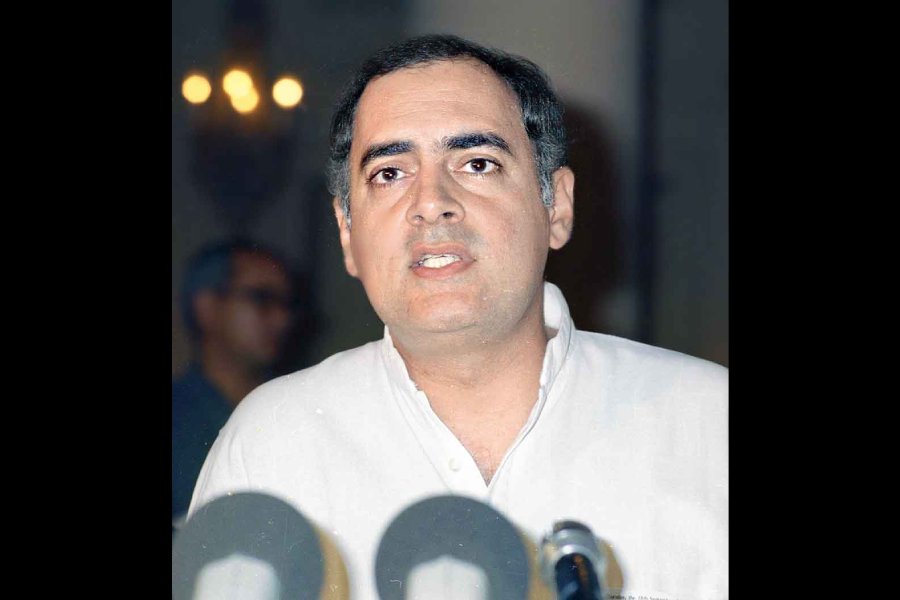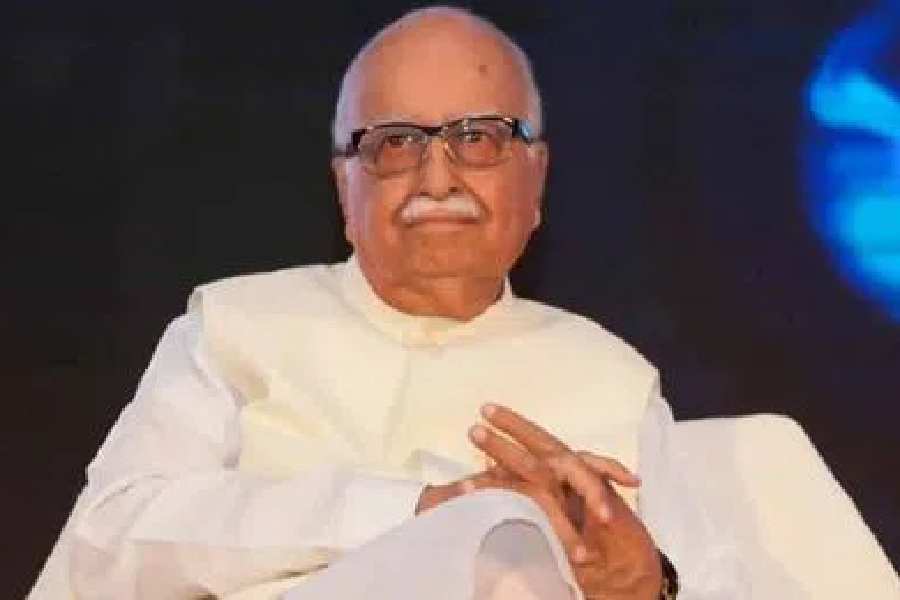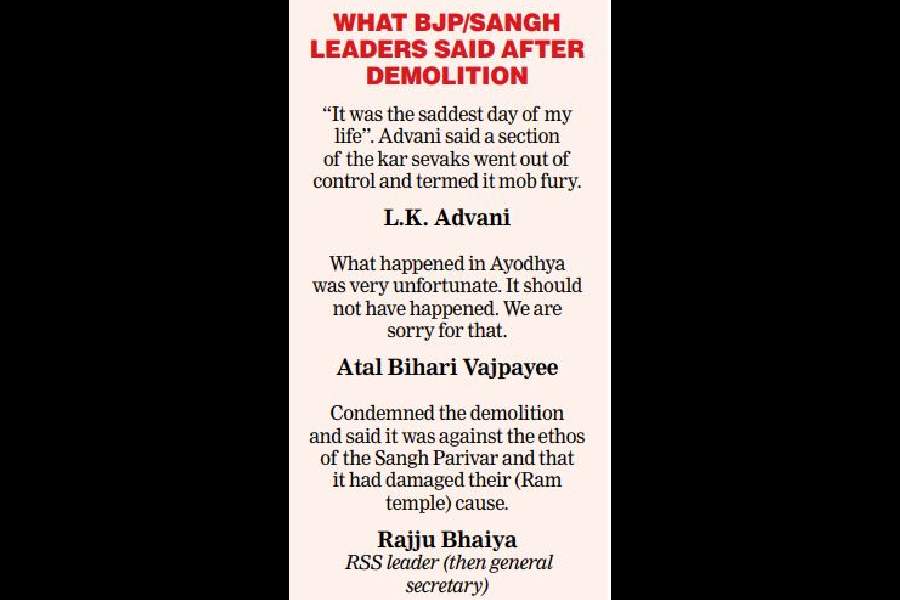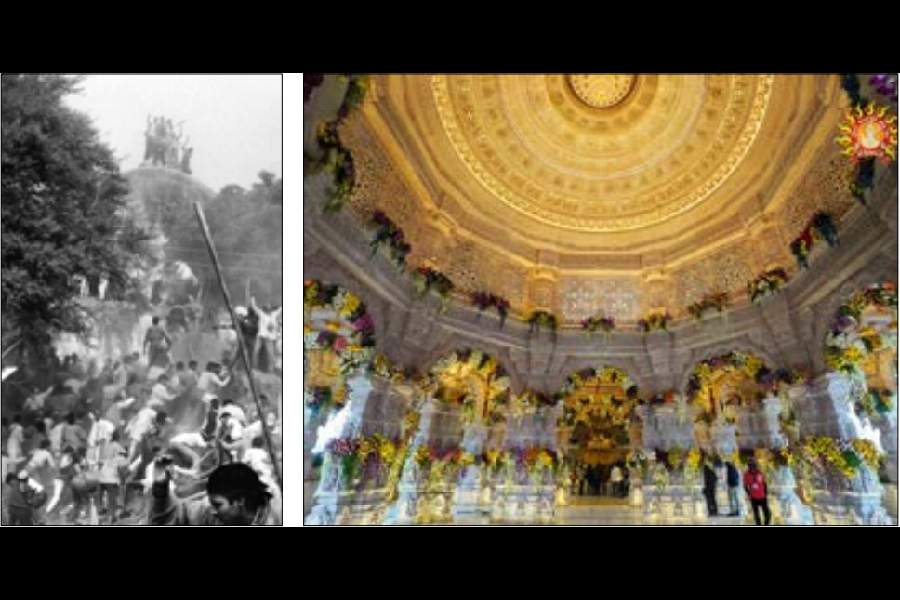At the heart of the dispute spanning more than 150 years was 2.77 acres of land in Ayodhya, atop which stood the Babri Masjid and which was claimed by Hindu religious bodies and later the Sangh Parivar to be the birthplace of Ram. During the time the dispute surged and ebbed, Independent India had 14 Prime Ministers and Uttar Pradesh, 21 chief ministers.
The runup to the demolition of the Babri Masjid on December 6, 1992, was politically volatile; it often plunged parts of the nation into violence, dozens of flashpoints of rioting and clashes. Alongside raged a monumental courtroom battle.
Witness statements comprised some 14,000 pages; 1,000 reference books and related documents filled out 21 steel cupboards. Through the course of the discord, the BJP, the political arrowhead of the Ayodhya temple movement, flourished. From 2 seats in the Lok Sabha in 1984 to 88 in 1989, 120 in 1991, 161 in 1996, 182 in 1998, 181 in 1999, 138 in 2004, 116 in 2009, 282 in 2014 and 303 in 2019.
A TIMELINE OF HOW WE HAVE ARRIVED AT THIS DAY
1858
Over two dozen Nihang Sikhs storm into Babri Mosque in Ayodhya and perform ‘havan’ (ritual), according to a police record. This is the first recorded attempt to stake a claim to the birthplace of Ram. Before this Hindus used to worship a spot outside the mosque as the birthplace of Ram. Post Nihang storming, Hindus began entering the mosque to worship.
1885
Mahant Raghubar Das, a monk of the Nirmohi Akhara sect, files a plea in Faizabad district court seeking permission to build a temple on the platform in the outer courtyard of the Babri Mosque. Court rejects the plea.
1949
Idols of Ram Lalla surreptiously placed under the central dome of the mosque. A large group of Hindus appears at the mosque on the intervening night of Dec 22-23, 1949, to place the idols. Many claim the appearance to be a ‘miracle’.
A Faizabad court attaches the mosque, bans entry of both Muslims and Hindus and hands over the site to an official receiver. The idols placed by the Hindu groups, however, are not removed.
1950
One suit filed in Faizabad district court by one Gopal Simla Visharad, seeking permission to worship the idols.
1959
Nirmohi Akhara files suit seeking rights to worship the Ram Lalla idols and later complete transfer of the site.
1961
The Sunni Central Waqf Board in a counter-suit seeks possession of the site.
1984–86
Vishwa Hindu Parishad launches movement for construction of Ram temple at the disputed site.
1986 February
Babri Mosque locks opened. A local court orders the government to open the site to Hindu worshippers. Politically, however, the then Rajiv Gandhi government was believed to have played a key role in getting the Babri mosque locks opened for Hindus.

Rajiv Gandhi
It was a bid to counter criticism over his government bowing to the demands of orthodox Muslims and getting a law passed to dilute the Supreme Court verdict in the Shah Bano case.
1986–87
RSS urges the government to transfer the disputed site as well as the adjacent land to the Ram Janmabhoomi Trust and demands a grand Ram temple to be built like the Somnath temple in Gujarat.
1989 August
Allahabad High Court orders status quo with respect to the disputed structure.
1989
A fresh suit is filed by a VHP leader in the name of Lord Ram for declaration of the title and possession in its favour at the Lucknow bench of Allahabad High Court. All the suits pending before the Faizabad district court transferred to a special bench of the high court.
1989 November
VHP performs shilanyas of the temple on land adjacent to the disputed site. Rajiv Gandhi opens poll campaign from Faizabad.
1989
The BJP for the first time joins the Ram temple movement. Party passes a political resolution at its Palampur session saying the dispute should be resolved through mutual dialogue between the two communities or, if this was not possible, through an enabling legislation. Asserts it is a matter of faith for Hindus and so litigation is in no way a solution for this matter.
1990 September
BJP stalwart L.K. Advani launches yatra from Somnath to Ayodhya, demanding construction of Ram temple.

L.K. Advani
1990 October 22
Advani arrested in Samastipur of Bihar. Despite Advani’s absence, the yatra proceeded with kar sevaks (VHP, RSS and BJP cadres) marching to Ayodhya.
1990 October 30
The police under the then Mulayam Singh Yadav government fired on the kar sevaks as they tried to scale the domes of the Babri Mosque in an attempt to raze it. Mosque remains intact.
1992 December 6
Babri Mosque demolished. Then a BJP government led by Kalyan Singh was in power. On the day thousands of kar sevaks had gathered for an event at a site adjoining the mosque. Top BJP leaders, Advani, Murli Manohar Joshi, Nritya Gopal Das and Sadhvi Ritambara gave fiery speeches, vowing to build a Ram temple at the site where the mosque stood.
The kar sevaks later stormed the Babri Mosque and demolished the entire structure within a few hours, despite an assurance by the Kalyan Singh government to the Supreme Court that the mosque would not be harmed. The police did not fire on the kar sevaks.

1992 December
Two FIRs are filed in the case. One against unknown kar sevaks for the demolition and the other against BJP leaders Advani, Joshi, Uma Bharati and others for giving communal speeches before the demolition. All are later acquitted of charges.
1992 December–1993 January
Communal riots break out across India.
1993
Centre acquires 67.7 acres of land in Ayodhya, including the disputed site.
1993 October
CBI files composite chargesheet accusing Advani and others of conspiracy.
1994
The acquisition of land is upheld by the Supreme Court. At the same time, the Lucknow bench of Allahabad High Court begins hearing the title case of the disputed area and orders an excavation.
2003
Archaeological Survey of India begins excavation of the disputed site.
2009
Liberhan commission enquiry report is submitted after 16 years of its constitution. The commission concluded that the December 6, 1992, Babri Mosque demolition was not spontaneous and was carried out with painstaking preparation and pre-planning.
2011 September
Allahabad High Court passes by a 2:1 majority, a verdict holding that both Hindus and Muslims were joint title holders of the disputed area. The 2.77-acre disputed area was divided between the Sunni Waqf Board, the Nirmohi Akhara and Ram Lalla.
2011 May
Supreme Court stays high court verdict on Ayodhya land dispute and orders status quo on appeal by both sides.
2017 March
Then Chief Justice of India, J.S. Khehar, suggests an out-of-court settlement of the dispute.
2017 August
SC constitutes a three-judge bench to hear the pleas of different parties to the dispute.
2018 February
SC begins hearing appeals to land dispute case.
2019 January
SC sets up a five-judge constitution bench headed by Chief Justice Ranjan Gogoi to hear the case. Daily hearings begin.
2019 November 9
SC delivers landmark verdict in favour of a temple at the disputed site. The SC orders that the disputed 2.77 acres be transferred to a trust to be set up by the government for construction of Ram temple, despite holding that the demolition of the mosque on Dec 6, 1992, was “an egregious violation of the rule of law”. The SC also ordered allocating 5 acres to Muslims in Ayodhya for building a mosque.
2020 February
Prime Minister Narendra Modi informs Parliament that the cabinet has decided to set up an autonomous trust — the Ram Janmabhoomi Teerth Kshetra Trust chaired by Mahant Nritya Gopal Das, head of the Ramjanmabhoomi Nyas — to construct and manage the temple.

PM Modi File picture
2020 August 5
Modi lays the foundation stone.
2022 January
Temple trust launches a 45-day nationwide fund raising campaign for the construction of the temple and claims to have collected over Rs 5,500 crore.
2024 Jan 22
Pran Pratishtha (consecration ceremony) of Ram Lalla’s idol, led by Prime Minister Narendra Modi, is scheduled a little after noon.










